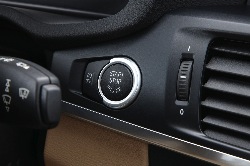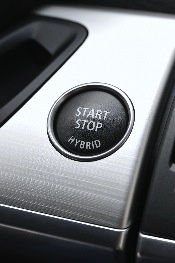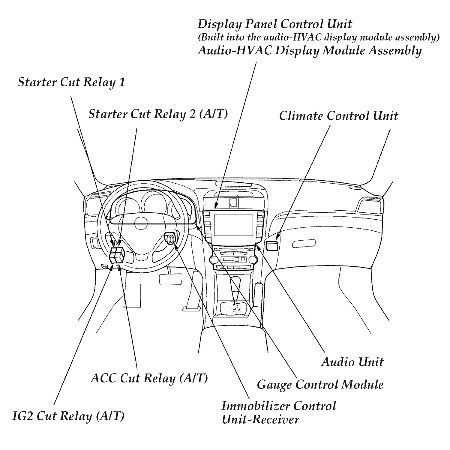
Push button keyless start systems began appearing on several import cars about six years ago, and are now being offered on more and more new vehicles, both import and domestic. Motorists say they like the push button keyless start systems because they are convenient to use. There’s no ignition key or switch to fumble with, and you don’t have to do anything other than have the smart fob in your pocket or purse when you get in the car. Just put your foot on the brake pedal (or depress the clutch pedal if the vehicle has a manual transmission) and push the Start button to start the engine (or activate the powertrain if the vehicle is a hybrid).
There’s also a certain amount of “cool” factor involved. Pressing on a red (or gray or black) Start button is kind of like pressing the launch button for a rocket. For those who own older vehicles that don’t have this cool bit of technology, there are aftermarket conversion kits that allow a push start button to be installed. These kits are not true keyless start systems because there is no smart fob. Instead, the starter motor solenoid circuit is wired through the start button. The vehicle owner still has to insert a key into the ignition switch and turn it to unlock the steering column and deactivate the immobilizer system.
HOW THESE SYSTEMS WORK
Basically, a keyless push button start system eliminates the need for a conventional ignition key and mechanical steering column switch. Security is provided by the smart fob, which uses a programmed ID code or rolling ID code to communicate with the vehicle’s anti-theft system. It’s no different than a conventional ignition key with an electronic chip communicating with the anti-theft system before the engine can be started.
The keyless smart fob is detected by one or more antennas located on the vehicle. The only difference is that the keyless push button start systems do more than just unlock the doors. Once the fob is used to unlock the door and/or is inside the vehicle, it’s the same as if the driver has inserted a key into the ignition switch and turned it to the “on” position. The smart fob transponder broadcasts its ID code to the keyless entry immobilizer module, which then authenticates the code.
The engine won’t start automatically for obvious safety reasons (same for energizing a hybrid-drive system), so nothing happens until the driver presses the Start button and issues a start command. When the start command is received via a hard-wired circuit to the PCM or the CAN communication bus, the PCM energizes the fuel and ignition systems, and current is routed to the starter to crank the engine.
An electronic steering lock is also released to unlock the steering column, and a signal is sent to the transmission controller (if separate from the PCM) to allow the transmission to be shifted out of Park.
Most systems require the same safety precautions as a conventional starting system. The transmission must be in Park (or Neutral) before the engine can be started, and the driver must depress and hold the brake pedal (or clutch pedal).

In the case of a hybrid application like a Toyota Prius, pushing the Power button tells the hybrid system controller that the driver is ready to go. The “Ready” light comes on telling the driver the transmission can now be placed in Drive or Reverse, and the car is ready to go.
On many vehicles, there is a receptacle in the dash for the smart fob. The receptacle’s purpose is to hold the fob so it doesn’t roll around inside the car, and to recognize and authenticate the smart fob ID code.
One misconception motorists have about the receptacle is that it recharges the fob. It does not. Most smart fobs use a small 3.0-volt lithium button battery for power. The battery powers the keyless entry transponder that sends out a coded signal to unlock or lock the doors, and to deactivate or activate the anti-theft system. Once the fob is inside the vehicle, or is placed into the dash receptacle, it’s mostly passive and uses minimal power to activate its transponder.
The battery inside the fob should usually last several years. Lithium batteries are not rechargeable, so when they eventually run down, the fob has to be pried open so the battery can be replaced. Always refer to the vehicle service information or owner’s manual for the type of battery required, and the proper procedure for replacing the battery. Figuring out how to open a fob isn’t always obvious, and if you use the wrong technique or brute force to pry it open, you’ll probably break it.
The fob may also have to be reprogrammed after the battery has been replaced. Some will retain their code settings while others may not. On VW applications, be careful not to press any buttons while the battery is out of the fob as doing so can erase the fob’s memory.
Push button keyless start systems have a mechanical backup in case the smart fob is defective. There may be an emergency key or a key that pulls out of the fob that can be inserted into a steering column or dash switch. Again, refer to the vehicle service information or owner’s manual for the backup start procedure if the fob is not working.
Additional features that may be part of a push button keyless start system include memory functions, such as changing the seat and mirror positions to suit different drivers, automatic door locking when the vehicle owner exits the vehicle with the smart fob, and the ability to prevent the vehicle owner from accidentally locking the fob inside the vehicle.
STOP FUNCTIONS
The same button that is used to start the engine (or to power up a hybrid-drive system) is also used to turn the engine off. This feature, unfortunately, has resulted in a number of deaths. Here’s what happens:
The motorist pulls their car into an attached garage and exits the vehicle, but leaves the key fob in the car and forgets to turn the engine off. The engine keeps running and carbon monoxide fumes build to dangerous levels inside the garage. Eventually, the fumes seep into the adjacent living quarters and overcome the people inside. Most of the victims to date have been elderly people who owned luxury import cars with relatively quiet engines.
When Toyota was having its “unintended acceleration” issue (which was blamed on interference between the accelerator pedal and incorrect floor mats, sticky accelerator pedals and/or driver error), the operating strategy of the start/stop button was also questioned as a possible cause of several fatalities.
On the Toyota Prius, the Power button must be pressed in and held for three full seconds to kill the engine if the car is being driven. A short tap or pressing the button repeatedly won’t do it. Why? Toyota says the three-second rule is necessary to prevent someone from accidentally bumping the button while driving and killing the engine (which would also kill their power steering assist and create a potentially dangerous situation).
WHEN THINGS GO WRONG
Great as this new technology is, like any other electronic gadgetry, things can and will go wrong. A common complaint is intermittent operation of the push start system. Usually the system works fine, but, sometimes, nothing happens when the start button is pressed.
On 2010 Hyundai Genesis and Coupe models, the cause of an intermittent no-start problem with the push start button usually turns out to be a defective brake pedal switch. The switch is not telling the system that the driver is depressing the brake pedal when the driver tries to start the engine. The fix is to replace the brake pedal switch (P/N 93810-3K000).
On some Volkswagen Passat and other models, the same kind of intermittent operation complaint usually has a different cause. On the VW applications, the problem isn’t the brake pedal switch, but a faulty ignition column immobilizer module.
Other oddities we’ve heard vehicle owners complain about with certain keyless push button start systems is that the smart fob may not always be recognized by the car when the fob is inside the car. The fob may have to be moved around until it can be “seen” by the inside antenna. Others have complained that the fob may be adversely affected by a nearby cell phone (we don’t know if that’s possible or not, but we wouldn’t rule it out entirely when trying to diagnose an intermittent no-start condition).

Possible causes of no-start with push button keyless systems:
In no particular order, we’ve listed some of the many possible causes of a no-start condition on a push button keyless system:
• Driver not pushing the button in far enough.
• Defective push button (or fault in push button wiring harness).
• Driver not depressing the brake pedal (automatic) or clutch pedal (manual).
• Defective brake or clutch pedal position switch (or fault in the switch wiring harness).
• Transmission not in Park (or Neutral).
• Defective Park/Neutral safety switch.
• Driver does not have the smart fob with them (forgot it), or has wrong fob for the car (if they own several cars with push button start systems).
• Smart fob has a problem (defective transponder, low or dead battery, or fob code is out of sync or is corrupted). You may see an error message that says, “fob not recognized.” Check/replace the fob battery first to see if that cures problem. If not, the fob may need to be reprogrammed or replaced.
• Vehicle antenna(s) does not recognize the smart fob (wiring problem or defective keyless antenna control module). You may get an error message that says, “fob not recognized.” Check signal strength with scan tool.
• Defective steering interlock release module.
• CAN bus communication fault (should set a “U” diagnostic trouble code).
• If the engine does not crank when the button is depressed, it could be a conventional electrical problem such as a dead car battery, bad starter relay or solenoid, bad starter or a fault in the starter circuit wiring harness.
• If the engine cranks but does not start, and the anti-theft light is not flashing, the fault is not likely in the push button start system. Check for fuel problems (bad fuel pump, fuel pump relay, plugged fuel filter, no gas in tank), ignition problems (like a bad crank sensor or ignition control module), or a mechanical problem (broken timing belt or broken teeth on flywheel).
DIAGNOSIS
On most of these systems, the best and fastest way to get to the core of a no-start problem is to use a factory scan tool (or an aftermarket scan tool that has similar software capabilities) to run whichever self-tests are available for the keyless start system.
On Nissans, for example, the Nissan Signal Tech II scan tool (which can also be used for the Tire Pressure Monitoring System) includes menu options for checking the intelligent key system relative signal strength, for testing the remote keyless entry relative signal strength and for checking the strength of the output signal from the vehicle keyless antenna. If an intelligent key fob or steering column lock is defective and has to be replaced, the IDs of the parts must be registered and programmed into the system — which is a dealer-only job that requires the factory Consult-III scan tool.
It’s the same story with other import makes. If you discover a defective smart fob, replacing it requires the same programming procedures as replacing or duplicating a key with an anti-theft chip. You’ll need a new car dealer or certified locksmith to do the programming.
Something else to keep in mind: if repairs require disconnecting the battery to replace an electronic component, make sure you have the factory radio and navigation system codes before you disconnect the battery so these devices can be reset afterward. Other on-board electronics may also require a relearn or reset procedure following a battery disconnect. Refer to the vehicle service literature to see what may be affected, and what’s required to get these systems operating again following a battery disconnect.













